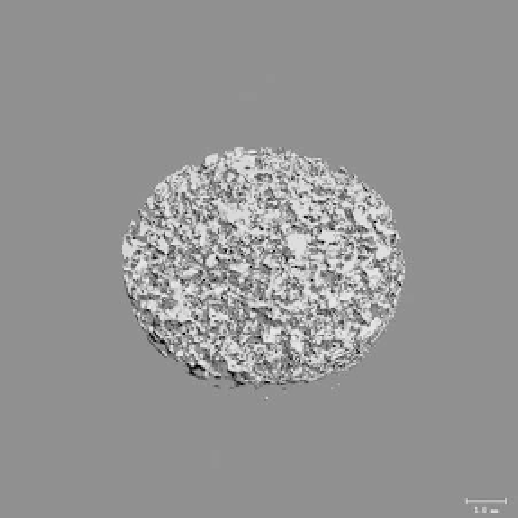Biomedical Engineering Reference
In-Depth Information
FIGURE 5.16
The scaffold from Figure 5.13
imaged by computer-aided x-ray tomography (micro-
CT).
Courtesy of Douglas J. Adams, PhD, Micro-CT Facil-
ity, University of Connecticut Health Center.
polymers (or other scaffold substrates) with relatively higher attenuation coefficients will
provide higher-contrast images and improved computational segmentation of scaffolds
versus the background. Commercial desktop micro-CT instruments are available with a
spatial resolution of approximately 5
m.
m
5.6.2 Methods for Testing and Evaluating Safety and Biocompatibility
It has been emphasized repeatedly in this chapter that tissue-biomaterial interactions are
a two-way street: implantation in a body affects the biomaterial, and the biomaterial affects
the body. Therefore, both of these aspects must be investigated prior to biomaterial implan-
tation in the human body. This is known as biocompatibility and safety testing. Before
initiating biocompatibility and safety testing, the structure and chemistry of the material
should be fully characterized by a combination of techniques, as described earlier in this
chapter. This is necessary to confirm the purity and identity of the biomaterial and to
ensure that no unintended foreign substances have been introduced during the synthesis,
manufacturing, and sterilization procedures.
Biocompatibility and safety tests include in vitro assays (using cells and tissues), in vivo
models (in animals), and, finally, human clinical trials. Several guidelines and procedures
have been developed by the standards organizations of the world (ASTM and the Interna-
tional Standards Organization [ISO]) and federal regulatory agencies (e.g., Food and Drug
Administration). ASTM Standard F-748 and ISO 10993 provide detailed methods for com-
pleting adequate safety and biocompatibility testing and are followed by all implant and
medical device manufacturers. The tests are separated into various categories based on
intended use. For example, there is a matrix of tests appropriate for surface devices, exter-
nal communicating devices, or implanted devices. The recommended tests are further


